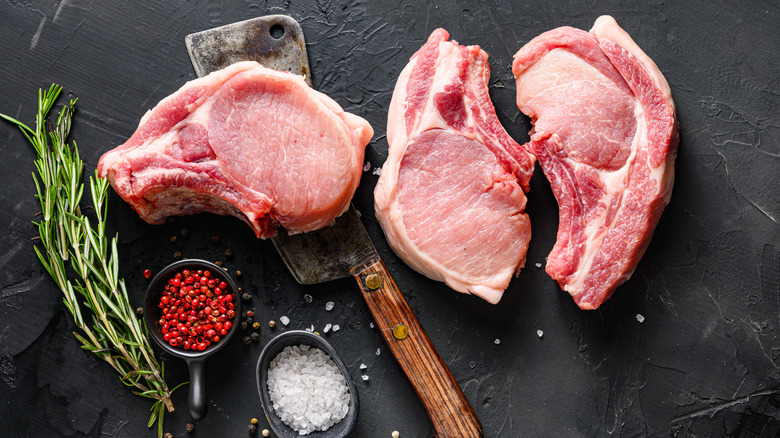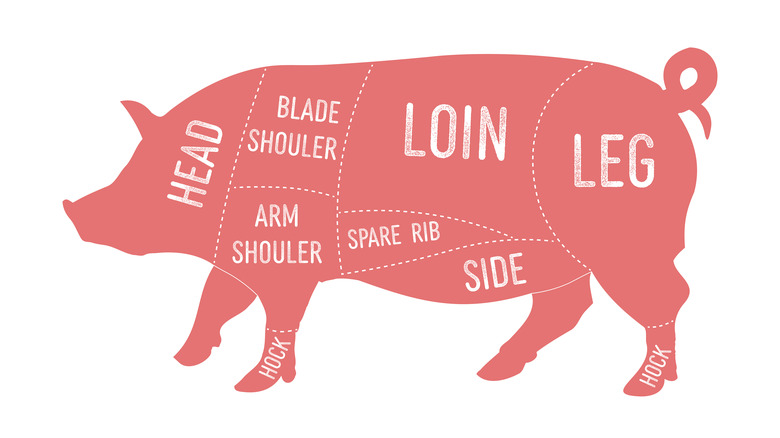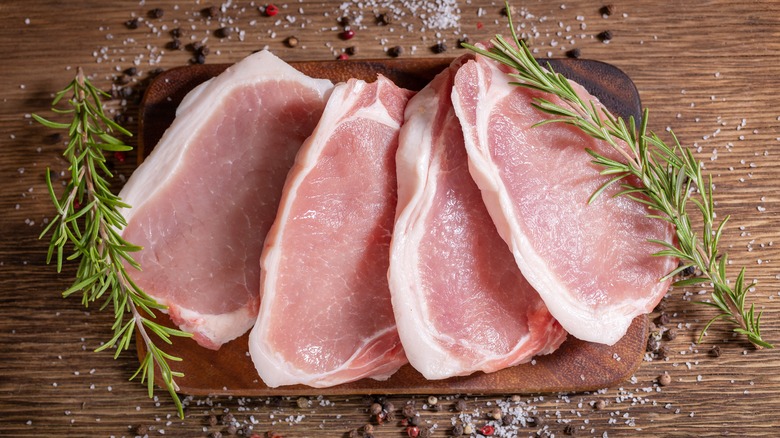What Part Of The Pig Is A Pork Chop?
In the world of domesticated livestock, there is no animal as beloved as the pig. According to D'Artagnan, the pig is the most commonly eaten animal throughout the world. Not only does pork have a ton of nutritional benefits, but they are easy to raise (via Healthline). In fact, A quick look at history tells us that this useful bit of information has been known for quite some time.
Pigs were first brought to the United States by Spanish explorers as a source of nutrition, and were essentially left to run wild and populate the "new world." They were omnivorous, grew to maturity in six months, and produced plenty of offspring. Byproducts of other food products like whey and kitchen scraps could also be used as an easy form of feed. If pork is king, then the pork chop is the king of kings.
The National Pork Board says that this versatile and tender cut is the most popular cut taken from the pig. It can quickly be seared in a pan or roasted in the oven. You can serve it with a crispy breading, and use the leftovers the next day. If you're going to cook pork chops correctly though, it's best to understand what kind of meat you're using, and where it comes from on a pig.
Knowing your pork cuts
When butchers approach a livestock animal to break it down into the many different cuts for sale, they start by separating it into what's known as the primal cuts. According to Vincent's Meat Market, there are four primal cuts on a pig.
The first is the pork leg. Vincent's Meat Market says that this is the back end of the pig. Cuts taken from this primal include the ham, which can be further broken down into steaks, or cured and aged into products like prosciutto and jamon de serrano. You'll also find ham hocks and pork cutlets here as well. On the opposite end of the pig is the pork shoulder. This cut contains more fat than the leg. Cook's Illustrated says this is where you'll find the pork butt roast and pork shoulder. Both of these cuts have some serious fat and connective tissues that make them great for slow roasting.
Another cut is the pork belly, which comes from the underside of the pig. This cut contains the most fat of any of the primal cuts. It's where butchers will take the meat for bacon, pancetta, and side ribs or St. Louis-style ribs. Above this fatty section, and running between the shoulder and leg is the pork loin. Cook's Illustrated points out that this section yields the most tender and lean meat of any of the cuts. This section of the pig is also where we will find the pork chop.
What cut is the pork chop from?
Vincent's Meat Market says that the loin is the section that runs along the pig's spine. Cook's Illustrated adds that there are actually several different types of pork chops that come from the loin, and their qualities can differ greatly depending on what section they're taken from.
The most common is the rib chop. It has the signature curving rib bone and strip of fat that most people identify with pork chops. Most boneless pork chops on the market will be a rib chop that has been deboned. This section comes from the upper half of the loin where the ribs are located.
Cook's Illustrated says that closer to the shoulder is the blade chop. This is a fatter and tougher chop. On the opposite end of the rib chop is the center cut chop. This unique chop actually contains meat from the loin and extra lean tenderloin. These can be difficult to cook for this reason because the two different cuts can cook at different speeds if cooked improperly.
Lastly is the sirloin chop. This chop is located closest to the pork leg, and is described by Cook's Illustrated as "tough, dry, and tasteless." Keep in mind that whichever chop you choose, the loin is known for being a tender and lean cut that easily dries out. Treat it with gentle heat and a close eye though, and you'll have an easy and delicious meal ready in no time.


